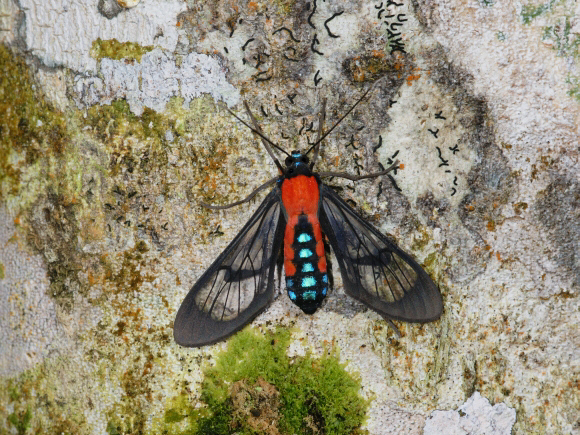Chemical mimicry
Visual mimicry is targeted at vertebrate predators – primarily birds and small reptiles. Butterflies and moths also use mimicry to protect themselves against insect predators, but in this instance chemical rather than visual mimicry is used.
Take for example the case of a caterpillar such as that of the Large Blue Maculinea arion, which is carnivorous during the latter part of its life, feeding on ant grubs within the underground nests of Myrmica sabuleti ants. The caterpillar had to evolve a way of protecting itself from the aggressive adult ants. It does this partly by appeasing the ants with ‘gifts’ of sugary fluids that it exudes from a dorsal ‘newcomers gland’, and partly by emitting chemical odours that fool the ants into thinking that the caterpillar is another ant.
The study of this pheromonal mimicry in butterflies is still in its infancy, but it will probably be found to be commonplace among Lycaenid butterflies, a high percentage of which spend the larval and pupal stages of their lifecycle in association with ants.

As in the case of thousands of other nocturnal species, males of the wasp mimic moth Cosmosoma myrodora are attracted by pheromones emitted by their females. As a myrodora male approaches a female, he hovers above her, and discharges a burst of very fine filaments which swirl in the air around her, and envelop her body.
American biologists Conner and Boada investigated the lifecycle and ecology of this moth. They found that Cosmosoma males are attracted to Eupatorium plants, and sequestered alkaloids from juices seeping from the stems. Such pyrrolizidine alkaloids are sequestered by a wide variety of butterfly genera including Ithomia, Pteronymia, Oleria, Lycorea and Danaus; and by several genera of moths in the family Arctiidae. The PAs stored in the bodies of the insects render them toxic or unpalatable to birds, and are a primary defence method in aposematic species.
The researchers found that in the case of Cosmosoma the toxins seemed to be directed mainly at predatory spiders. Moths caught in the webs of Nephila clavipes were cut free from the webs by the spider, but moths which had been deprived of the opportunity to sequester PAs were consumed.
Conner and Boada found that PAs were passed to females via the discharged filaments, and also via spermatophores delivered during copulation. The PA toxins conveyed to females were found to provide them with protection against predators during the following nights, enabling them to lay their eggs unmolested. It was also demonstrated that the toxins were passed to the eggs, and provided them with protection against ants, Coccinellid beetles ( ladybirds ) and Chrysopid larvae.
Stinging
Butterflies and moths do not sting in the sense that a wasp or bee does, but a significant number of species, particularly tropical ones, have spikes or setae (‘hairs’) which have urticating properties. If touched, the hairs break and release formic acid, or strong alkaloids that can cause irritation or cause a skin rash on humans. This type of defence is found mainly in the caterpillars of the moth family Lasiocampidae, and is probably targeted against insectivorous birds and small reptiles.
A much more dangerous chemical defence system is found in the caterpillars of Lonomia obliqua, which can be found clustered in groups of up to 100 on tree trunks in the Amazon rainforest. There have been numerous incidents where people have unwittingly touched or rubbed their arm against these caterpillars.
The effects of a dose from multiple caterpillars can be very severe, including massive intercranial haemorrhaging and kidney failure. Lonomia obliqua caterpillars are a frequent cause of death in southern Brazil – 354 people died between 1989 and 2005. The fatality rate is about 1.7% – roughly equivalent to that of rattlesnake bites.
Reflex bleeding
The caterpillars of several butterflies including the Large White Pieris brassicae will reflex-bleed if alarmed, and exude toxins from their mouthparts. These fluids are sufficiently noxious to dissuade insectivorous birds, which invariably drop them and then frantically wipe their beaks to remove any trace of the toxins.
A similar form of defence is used by Pericopiine moths in South America, which exude a hemolymph foam from their mouths and spiracles if gripped. Any bird attempting to grip the moth in its beak will experience a very unpleasant taste, and will instantly drop the moth, allowing it to escape.
